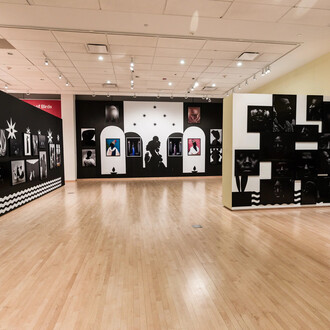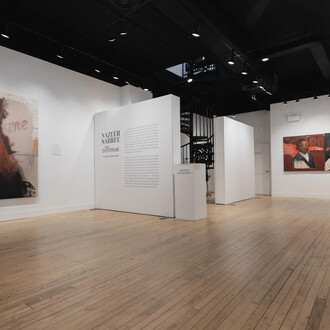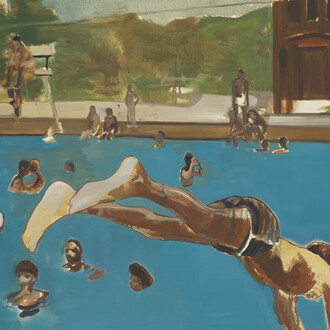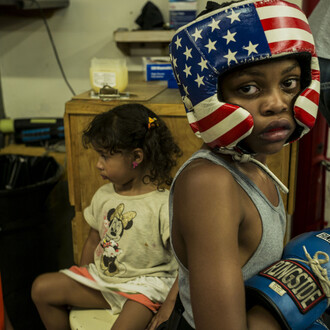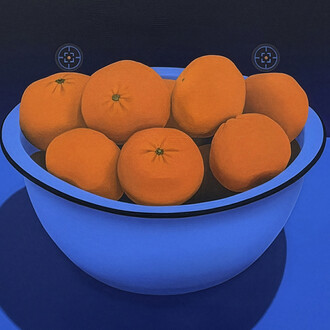Paradigm Gallery + Studio is pleased to present Nightshades, a solo exhibition of works on paper by London-based painter Megan Rea in partnership with independent curator Anaïs Cooper-Hackman. Rea’s debut solo exhibition in Philadelphia will feature oil paintings on hand-crafted paper inspired by the classical architecture displayed in Italian frescos. Rea focuses on the looming towers and tiered fountains decorating the frescos' backgrounds and bringing them to the forefront as main characters in her work. She identifies the falling streams and ornamental armature of these structures as living qualities and explores fountains as representations of the human form. By incorporating hand-embellishments and mystical imagery, Rea constructs a poetic narrative of the body’s relationship with time as if it were weathered stone.
From the curator:
As the most universal of experiences, death should be a space for connection, but the awesomeness of the unknown and our cultural proclivity to avoid it often inspires existential dread instead. This body, which used to open doors and garner smiles before the patina of youth faded, will age and crease and weaken and suddenly become invisible as the spotlight shifts to fresher faces. This invisibility can be both a source of isolation and empowerment. Nightshades is inspired by the denial of death and the corresponding obsession with youth that quietly and profoundly drives our culture, as well as the personal liberation and self-actualization only accessible to us through the process of aging.
Rea’s Fountain series began with a particularly poignant viewing of The triumph of death, a fifteenth-century Italian fresco depicting a theme common to the European Renaissance period. In the center of the fresco, a skeleton–a vision of death–astride a skeletal horse infiltrates a lush garden. In the top right corner of the fresco sits an active fountain, the essence of life in the face of our inevitable mortality.
Rea’s work is influenced largely by medieval art, specifically the shallow depth of field and flatness used to tell the epic stories often depicted. Her compositions elevate background elements to the foreground, highlighting the structures that underpin the chaos of The triumph of death and so many other medieval paintings. In the face of these existential themes, Rea’s pleasantly symmetrical paintings with their romantic color palettes are life-affirming. They immortalize the reflective moments where we wonder at the miracle of life.
“The new fountain pieces harken back to themes I explored earlier in the year”, says Rea. “I was inspired by the stories of Italian Saints, particularly that of St. Anthony, who communicated with the fish after the people in the town of Rimini refused to listen to him. The water spouting from the fish heads reminds me of those emerging from the water in the fresco depicting the miracle”.
Through the collection of new works on view, the artist emphasizes texture through mark-making. The process begins with the artist using a variety of materials from torn cartridge paper to newsprint to create handmade paper. After applying layers of oil paint to the surface, the result gives the impression of architectural artifacts recovered from the medieval churches of Europe. She scratches and scores the paintings to produce the illusion of age and erosion, and conceals the materiality of the paper, which could easily be mistaken for stone upon first look. This approach allows for gems of paint from earlier washes to be caught and shine through. The variety in her mark-making makes the fragment’s appearance as one full, historic object all the more convincing.
Though inspired by Rea’s travels to Florence and other parts of Italy and the seminal fresco cycles of Giotto’s Scrovegni Chapel, the compositions depict imagined places. In Carry me up to the place I once lazed, Rea shifts the focus to composition with anthropomorphized fountains whose fantastical streams wave wildly like limbs and glisten with aliveness. Upon viewing June chorus, you can practically hear the splashing of the fountain collide with a sea of chirping nocturnal insects as the moon reflects up at you from the inky black water. The wash of colors across the painting feels synesthetic, conjuring the delicate fragrance of late spring blooms.
“Megan’s work delicately highlights the beauty in the ephemeral nature of life”, says Cooper-Hackman. “By tapping into iconographic themes that have been investigated by artists for centuries, her works allow us to escape the transitory reality of our individual life and connect with the dazzling tapestry of humanity. These works contribute to the most ancient tradition of meaning-making our species has, storytelling”.
After graduating from the Edinburgh College of Art, *Megan Rea received a scholarship to study in Florence. During her time there, her focus shifted from the external features of medieval architecture to the 13th-15th century Italian frescoes adorning church walls. Rea also takes inspiration from paintings made in the Middle Ages as well as gothic design; collisions between the imaginary and the reliquary suggest a rediscovery of a life once lived, or perhaps one yet to be.
During the pandemic when access to art supplies became limited, Rea began working on homemade blended paper, whose malleability, freedom of the form, flexibility, and the array of densities and sizes created exciting opportunities for her work. By shaping the paper from pulp, Rea is able to experiment with irregular forms, giving the paintings the appearance of a preserved ruin. The irregular perimeter of the paintings holds qualities of an eroding exterior and further plays with the idea of synthetic time. The paper surface is pocked, allowing gems of paint from early washes to be caught and shine through the layers applied. Symmetry and multiples are the focus of new paintings, using narratives from Italian Saints as the inspiration for painted stone structures.
Rea’s work has been the subject of solo exhibitions at Stellarhighway, NYC; Arusha Gallery, Edinburgh, Scotland; and Copeland Park in London, UK.
Group exhibitions include those at Bloom Galerie, St. Tropez, FR; Janet Rady Fine Art, London, UK; The Tub, London, UK; and, Studi0, Zurich, CH. Her work has been published twice in Artmaze Magazine. She was also a recipient of the John Kinross Scholarship, an RSA New Contemporaries selection and the Open Contemporary Young Artist Award, and shortlisted for the HIX Award. Rea lives and works in East London.
Anaïs Cooper-Hackman is a curator based in Philadelphia, PA. She is the former Associate Director of the now defunct HOT•BED Gallery, an art gallery, event venue, and artist studios in Philadelphia. Among many things, during her time at Hot•bed she helped launch a concept called Micro•gallery, a no-limits playground for guest curators and artists to produce and exhibit unconventional work. The inaugural season of Micro•gallery included a Venice Biennale of Architecture-bound installation by Jefferson University’s Synesthetic Research and Design Lab, a community media lab for the production of experimental art in partnership with Lino Kino, and an immersive neon cave installation by neon bender Alissa Eberle. Currently, she is the Programming & Partnerships Director at Ray, a multi-family real estate company with locations in Philadelphia, PA; Harlem, NY; and Phoenix, AZ where she manages an in-house gallery concept called Studio 105.
After a couple of recent encounters with premature death, Cooper-Hackman became aware of how unprepared we are to talk about the universal experience to those actively dying and their loved ones. Her current fascination is improving our relationship to death and in so doing, to life, by honoring it as a sacred process that should be experienced in community. She is also a cacao ceremonialist, studying and co-facilitates womb healing ceremonies with her mother, Tiffany Cooper.





